外研社高二英语动词的时态语态精讲教案
高考英语动词及动词短语精讲教案
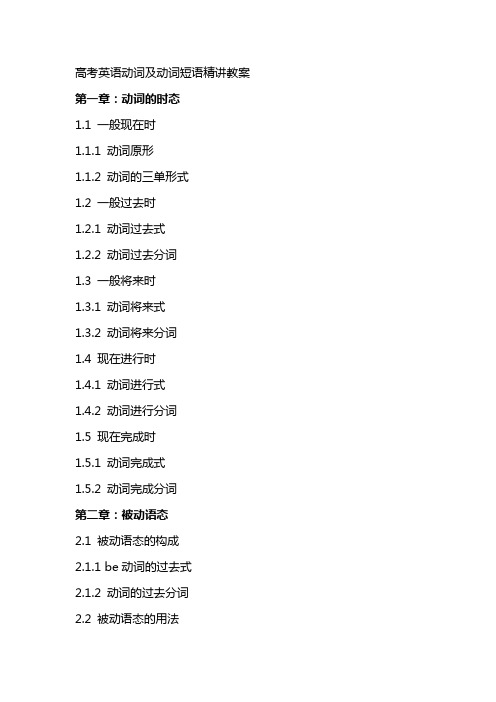
高考英语动词及动词短语精讲教案第一章:动词的时态1.1 一般现在时1.1.1 动词原形1.1.2 动词的三单形式1.2 一般过去时1.2.1 动词过去式1.2.2 动词过去分词1.3 一般将来时1.3.1 动词将来式1.3.2 动词将来分词1.4 现在进行时1.4.1 动词进行式1.4.2 动词进行分词1.5 现在完成时1.5.1 动词完成式1.5.2 动词完成分词第二章:被动语态2.1 被动语态的构成2.1.1 be动词的过去式2.1.2 动词的过去分词2.2 被动语态的用法2.2.1 表达动作的承受者2.2.2 强调动作的承受者2.3 被动语态的转换2.3.1 将主动语态转换为被动语态2.3.2 将被动语态转换为主动语态第三章:情态动词3.1 can和may3.1.1 表示能力3.1.2 表示请求3.2 must和have to3.2.1 表示必须3.2.2 表示需要3.3 shall和will3.3.1 表示承诺3.3.2 表示意愿3.4 should和ought to3.4.1 表示应该3.4.2 表示建议第四章:动词短语4.1 动词+副词4.1.1 举例:look after,run quickly 4.2 动词+介词4.2.1 举例:put on,go to4.3 动词+名词4.3.1 举例:make a decision,take a picture 4.4 动词+动词4.4.1 举例:try to do,help with第五章:动词辨析5.1 动词词义辨析5.1.1 举例:see-watch,read-study5.2 动词搭配辨析5.2.1 举例:make-have,get-obtn5.3 动词时态辨析5.3.1 举例:go-went,do-did第六章:动词的语态6.1 主动语态6.1.1 动词原形6.1.2 动词的进行式6.2 被动语态6.2.1 be动词的过去式6.2.2 动词的过去分词6.3 语态的转换6.3.1 主动语态转换为被动语态6.3.2 被动语态转换为主动语态第七章:情态动词的用法7.1 can和may7.1.1 表示能力7.1.2 表示请求7.2 must和have to7.2.1 表示必须7.2.2 表示需要7.3 shall和will7.3.1 表示承诺7.3.2 表示意愿7.4 should和ought to7.4.1 表示应该7.4.2 表示建议第八章:动词短语的辨析8.1 动词+副词8.1.1 举例:look after,run quickly8.2 动词+介词8.2.1 举例:put on,go to8.3 动词+名词8.3.1 举例:make a decision,take a picture 8.4 动词+动词8.4.1 举例:try to do,help with第九章:动词辨析与应用9.1 动词词义辨析9.1.1 举例:see-watch,read-study 9.2 动词搭配辨析9.2.1 举例:make-have,get-obtn 9.3 动词时态辨析9.3.1 举例:go-went,do-did9.4 动词在特定语境中的应用9.4.1 举例:put off,make up第十章:动词综合练习10.1 动词填空练习10.1.1 选择合适的动词形式填空10.1.2 根据语境选择正确的动词时态10.2 动词短语选择练习10.2.1 根据语境选择合适的动词短语10.2.2 改写句子,使用不同的动词短语10.3 动词辨析练习10.3.1 选择正确的动词10.3.2 根据语境选择合适的动词形式第十一章:动词与介词的搭配11.1 常见介词与动词的搭配11.1.1 举例:get up,put down11.2.1 表示位置关系11.2.2 表示动作方向11.3 动词与介词搭配的练习11.3.1 根据语境选择合适的介词11.3.2 完成句子,使用给定的动词和介词第十二章:动词与副词的搭配12.1 常见副词与动词的搭配12.1.1 举例:run quickly,speak loudly 12.2 动词与副词搭配的意义12.2.1 表示程度12.2.2 表示方式12.3 动词与副词搭配的练习12.3.1 根据语境选择合适的副词12.3.2 改写句子,使用不同的副词第十三章:动词与名词的搭配13.1 动词与名词搭配的类型13.1.1 动宾搭配13.1.2 动状搭配13.2 动词与名词搭配的意义13.2.1 表示动作的对象13.2.2 表示动作的状态13.3.1 根据语境选择合适的名词13.3.2 完成句子,使用给定的动词和名词第十四章:动词与形容词的搭配14.1 动词与形容词搭配的类型14.1.1 动词+形容词作宾语14.1.2 动词+形容词作状语14.2 动词与形容词搭配的意义14.2.1 表示主语的状态14.2.2 表示动作的特点14.3 动词与形容词搭配的练习14.3.1 根据语境选择合适的形容词14.3.2 改写句子,使用不同的形容词第十五章:动词综合应用15.1 动词在不同语境中的应用15.1.1 口语交流15.1.2 书面表达15.2 动词短语的创造性使用15.2.1 改写句子,使用不同的动词短语15.2.2 创作短文,运用所学动词和短语15.3 动词复习与测试15.3.1 完成填空题15.3.2 解答选择题重点和难点解析1. 动词的时态:一般现在时、一般过去时、一般将来时、现在进行时和现在完成时。
动词的时态和语态教案
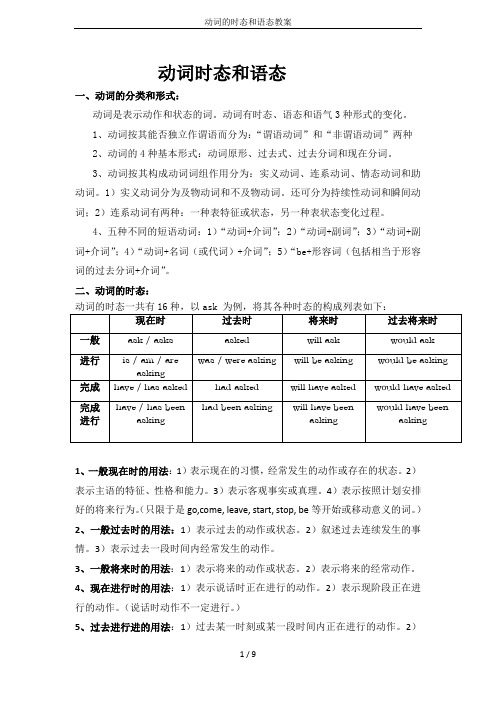
动词时态和语态一、动词的分类和形式:动词是表示动作和状态的词。
动词有时态、语态和语气3种形式的变化。
1、动词按其能否独立作谓语而分为:“谓语动词”和“非谓语动词”两种2、动词的4种基本形式:动词原形、过去式、过去分词和现在分词。
3、动词按其构成动词词组作用分为:实义动词、连系动词、情态动词和助动词。
1)实义动词分为及物动词和不及物动词。
还可分为持续性动词和瞬间动词;2)连系动词有两种:一种表特征或状态,另一种表状态变化过程。
4、五种不同的短语动词:1)“动词+介词”;2)“动词+副词”;3)“动词+副词+介词”;4)“动词+名词(或代词)+介词”;5)“be+形容词(包括相当于形容词的过去分词+介词”。
二、动词的时态:1、一般现在时的用法:1)表示现在的习惯,经常发生的动作或存在的状态。
2)表示主语的特征、性格和能力。
3)表示客观事实或真理。
4)表示按照计划安排(只限于是go,come, leave, start, stop, be等开始或移动意义的词。
)好的将来行为。
2、一般过去时的用法:1)表示过去的动作或状态。
2)叙述过去连续发生的事情。
3)表示过去一段时间内经常发生的动作。
3、一般将来时的用法:1)表示将来的动作或状态。
2)表示将来的经常动作。
4、现在进行时的用法:1)表示说话时正在进行的动作。
2)表示现阶段正在进行的动作。
(说话时动作不一定进行。
)5、过去进行进的用法:1)过去某一时刻或某一段时间内正在进行的动作。
2)表示移动的动词:come, start, stay, leave, go等词的过去进行时可以表示过去的将来要发生的动作。
3)was going to do可以表示在过去某一时间之后发生的动作。
6、现在完成时的用法:1)表示刚刚完成的动作,常与just连用。
2)表示过去发生而持续到现在的动作或状态,甚至延续到将来。
常与since, for连用,但for, since不能与终止性的动词连用。
高考英语动词及动词短语精讲教案

高考英语动词及动词短语精讲教案一、教学目标:1. 让学生掌握高考常见的动词及其词义、搭配和用法。
2. 提高学生对动词短语的识别和运用能力。
3. 培养学生运用所学知识进行口语表达和写作的能力。
二、教学内容:1. 动词的分类及用法2. 动词短语的识别和运用3. 动词与介词、副词的搭配4. 动词的时态和语态5. 动词及动词短语在句中的位置和功能三、教学重点与难点:1. 重点:动词的分类、用法,动词短语的识别和运用。
2. 难点:动词与介词、副词的搭配,动词的时态和语态。
四、教学方法:1. 任务型教学法:通过完成各种任务,让学生在实践中学习和运用动词及动词短语。
2. 互动式教学法:引导学生进行小组讨论和合作,提高学生的口语表达和交流能力。
3. 案例分析法:通过分析典型例句,让学生掌握动词及动词短语的用法。
五、教学步骤:1. 引入:通过提问方式引导学生回顾已学过的动词及其用法。
2. 新课导入:介绍本节课要学习的动词及其词义、搭配和用法。
3. 讲解与练习:讲解动词与介词、副词的搭配,动词的时态和语态。
通过练习题让学生巩固所学知识。
4. 动词短语的学习:介绍本节课要学习的动词短语,讲解其意义和用法。
5. 小组讨论:让学生分组讨论如何运用所学知识进行口语表达和写作。
6. 案例分析:分析典型例句,让学生掌握动词及动词短语的用法。
7. 课堂小结:总结本节课所学内容,强调重点和难点。
8. 作业布置:布置相关练习题,巩固所学知识。
9. 课后反思:教师反思教学效果,针对学生的掌握情况调整教学策略。
10. 课后辅导:针对学生的疑问进行个别辅导,提高学生的学习效果。
六、教学评价:1. 课堂参与度:观察学生在课堂上的参与情况,是否积极回答问题、参与讨论。
2. 练习完成情况:检查学生完成练习的情况,包括正确率和完成时间。
3. 小组讨论:评价学生在小组讨论中的表现,包括口语表达和合作能力。
4. 课后作业:检查学生完成课后作业的情况,包括正确率和完成时间。
高中英语动词的时态和语态教案

动词的时态和语态时态一般现在时(1)可表示客观真理、科学事实。
The sun rises in the east and sets in the west.太阳从东方升起,从西方落下。
(2)可用在由if,unless引导的条件状语从句,由even/if/though引导的让步状语从句,由when,before,until/till,as soon as,the moment引导的时间状语从句,由no matterwhat/who/when/where/how或whatever,whoever等引导的让步状语从句中,这时主句往往表将来或主句是祈使句。
I'll go with you as soon as I finish it.我一做完,就与你一同去。
Whatever you say,I will not change my mind.无论你说什么,我都不会改变主意。
一般过去时表示“刚才,在过去”之意,暗示现在已“不再这样”。
—Your phone number again?I didn't quite catch it.——再重述一下你的电话码好吗?我没记下来。
—It's 9568686.——是9568686。
一般将来时(1)“will+动词原形”表示事物的固有属性与必然趋势。
Fish will die without water.离开水,鱼就会死。
(2)“be going to+动词原形”可表示根据迹象对未来进行推断。
Look at the dark clouds.It is going to rain.看那乌云,要下雨了。
(3)“be about to+动词原形”表示立即的将来,很少与时间状语连用。
The train is about to start.火车就要开了。
(4)位移动词如e,go,arrive等,其一般现在时表按时间表将要发生的事,现在进行时可表计划、安排要做的事。
高考英语动词及动词短语精讲教案
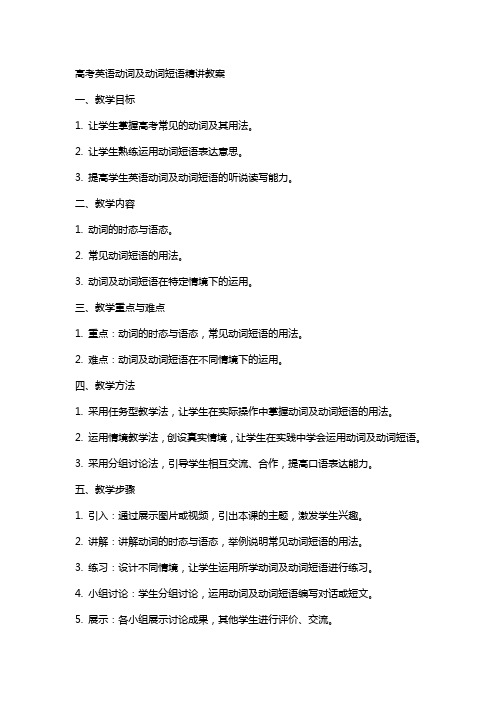
高考英语动词及动词短语精讲教案一、教学目标1. 让学生掌握高考常见的动词及其用法。
2. 让学生熟练运用动词短语表达意思。
3. 提高学生英语动词及动词短语的听说读写能力。
二、教学内容1. 动词的时态与语态。
2. 常见动词短语的用法。
3. 动词及动词短语在特定情境下的运用。
三、教学重点与难点1. 重点:动词的时态与语态,常见动词短语的用法。
2. 难点:动词及动词短语在不同情境下的运用。
四、教学方法1. 采用任务型教学法,让学生在实际操作中掌握动词及动词短语的用法。
2. 运用情境教学法,创设真实情境,让学生在实践中学会运用动词及动词短语。
3. 采用分组讨论法,引导学生相互交流、合作,提高口语表达能力。
五、教学步骤1. 引入:通过展示图片或视频,引出本课的主题,激发学生兴趣。
2. 讲解:讲解动词的时态与语态,举例说明常见动词短语的用法。
3. 练习:设计不同情境,让学生运用所学动词及动词短语进行练习。
4. 小组讨论:学生分组讨论,运用动词及动词短语编写对话或短文。
5. 展示:各小组展示讨论成果,其他学生进行评价、交流。
7. 作业:布置相关练习题,巩固所学知识。
六、教学评价1. 课堂参与度:观察学生在课堂上的积极参与情况,包括回答问题、讨论和展示等。
2. 作业完成情况:检查学生完成的练习题和作业,评估其对动词及动词短语的掌握程度。
3. 口语表达能力:评估学生在小组讨论和展示中的口语表达能力,以及他们在实际情境中运用动词及动词短语的能力。
七、教学延伸1. 进行拓展练习,如动词及动词短语的填空题、改错题等,以加深学生对知识点的理解。
2. 组织英语角活动,让学生在实际交流中运用所学动词及动词短语,提高口语水平。
3. 鼓励学生阅读英语文章,积累更多的动词及动词短语,扩大词汇量。
八、教学反思在课后,教师应反思本节课的教学效果,包括学生的参与度、教学内容的难易程度、教学方法的选择等。
根据反思结果,调整教学策略,以提高后续教学的效果。
动词的时态和语态教案

动词的时态和语态教案动词的时态和语态⼀.教学⽬标:从宏观⾓度把握动词的时态和语态的⽤法⼆.教学重点,难点:1.动词时态的构成,⽤法及中考考点。
2.被动语态的⽤法3.被动语态的特殊⽤法三.教学辅助⼯具:图画,练习题四.教学步骤:1.Greeting: Say hello to the student.2.Warm-up: Sing an English song about some verbs.3.Revision: The classify of Verb.4.Leading-in: Ask students“when do they get up everyday”and “When do they go to school” in Chinese. Then,Tell them what is Simple Present tense. According to thiskind of way, we can learn the other tenses.5.Teaching content:动词的时态从分类的⾓度⼀般现在时⼀般过去时⼀般将来时现在进⾏时现在完成时过去进⾏时过去完成时过去将来时从中考考点的⾓度⼀般现在时⼀从构成的⾓度:肯定式:主语+ 动词原形+ ….They speak English and French .主语+ 动词三单:She studies in a school near here.否定句:主语+助动词do/does+not+动词原形He doesn’t feel very well.⼀般疑问句: Do/does+主语+动词原形Do you speak English?回答: Yes,主语+do/doesNo,主语+don’t/doesn’t实义动词have当”有”讲时,疑问句有以下变化形式:Have you a penfriend?Do you have a penfriend ?Have you got a penfriend?特殊疑问句:特殊疑问词(where,when,how,why)+do/does+主语+动词原形(不⽤yes,no回答)Where does ZhouNan study?选择疑问句:Do you like this book or that one?⼆从⽤法的⾓度:1.表⽰经常性,习惯性的动作或经常存在的状态,常与always,often,usually,everyday,sometime等连⽤(通常⽤于be后,⾏为动词前)e.g.)Lei Feng is always ready to help other.I am always/usually go to school at 7 o’clock.2.表⽰普遍性的真理与规律The moon goes round the esrth.⽉亮绕着地球转.Light travels faster than sound.3.表⽰习惯与能⼒Do you drive a car? 你会开车吗?Mr Green teaches English.4.表⽰按规定,计划或安排预计要发⽣的动作或存在状态(主要⽤于come,go,leave,begin,start,arrive,return等瞬间动词)Could you tell me what time the plan leaves?Do you know what time the plan arrives in Moscow?5.在时间,条件状语从句中表⽰将来动作When you climb higher, you’ll find nothing grows there at all.Tom won’t feel well till the game is over.6.⼀般现在时表将来表最近的将来,说话⼈说话时动作并未发⽣,但即将开始(I’m off now .)或强调未来的事实和早已规定的事. ( Tomrrow is Sunday.)特殊⽤法⾓度:1.表⽰说话时刻,这⼀刻往往很短暂.What time is it now ?My watch says ten to seven.2.有些表⽰⼼理状态和感情,感觉的动词常⽤于⼀般现在时I feel better now.It doesn’t matter t his time .Does it hurn here?3 ⽤于下列句型中There goes the bell.Why don’t you go by bus?Why don’t/they/we +动词原形Why doesn’t he +动词原形Why not have a drink of tea?Here comes Jim..⼀般过去时⼀.从构成的⾓度:肯定式:主语+动词的过去式I wanted to watch animals in the zoo.They took his son to the cinema.否定式:主语+didn’t+动词原形I didn’t have his telephone number.⼀般疑问句:特殊疑问词+did+主语What sport did she play yesterday?⼀般过去时没有⼈称及数的变化⼆.从基本⽤法的⾓度:1.表⽰过去某时发⽣的动作或存在的状态.(常与其连⽤的时间状语有:yesterday ,the day before yesterday ,a moment ago ,just now ,in May, in 1999,lastnight/week/month/year ,once ,one day ,before… at the age of 18,when she was five…等)e.g.)He was a soldier two years ago.They had a baby last month.2.表⽰过去经常或反复发⽣的动作或⾏为(never ,often ,always)e.g.)They didn’t pass the ball often enough.He always took off his shoes and threw on the floor.3.根据时态⼀致,在宾语从句中⽤⼀般过去时代替⼀般现在时e.g.)She asked weather they needed some more tea.(瞬问的动作是过去,”需要”指现在)He said that there wasn’t time to go to the city century.过去了现在4.⽤于since从句,(主句的谓语动词为现在完成时,其后since从句为⼀般过去式)He has worked there since it opened in 1989.It has been two days since I came back.5.由于when,while,before,after,whenever等引导的表⽰过去时间的状语从句常⽤过去时.e.g.)The boy began to go to school when he was five.They lived there before they came to China.6.有些情况和事件,发⽣的时间不很清楚,但实际已发⽣,应当⽤过去时态.Look at the bags.They came.Five people died in the traffic accident.特殊⽤法的⾓度1.在时间,条件状语从句中表⽰过去将来的动作.If we won the match,we would be top.2.⼀般过去时形式上为过去时,实指现在I didn’t know you were th ere.(刚才不知,现在知道了.)⼀般将来时⼀:从构成的⾓度:肯定形式:主语+will+动词原形/主语+ Am/is /are +going to 动词原形否定形式:都是在will/am/is /are这些助动词后加not即可。
动词时态和语态教案

动词时态和语态教案第一章:引言1.1 目的:让学生了解动词时态和语态的概念及其重要性。
1.2 内容:动词时态的概念和分类动词语态的概念和分类1.3 教学方法:讲授法:讲解动词时态和语态的概念及分类互动法:引导学生举例说明和练习第二章:动词的现在时态2.1 目的:让学生掌握现在时态的用法和构成。
2.2 内容:现在时态的定义和分类现在时态的构成和用法2.3 教学方法:讲授法:讲解现在时态的定义、分类和构成练习法:让学生通过练习题巩固现在时态的用法第三章:动词的过去时态3.1 目的:让学生掌握过去时态的用法和构成。
3.2 内容:过去时态的定义和分类过去时态的构成和用法3.3 教学方法:讲授法:讲解过去时态的定义、分类和构成练习法:让学生通过练习题巩固过去时态的用法第四章:动词的将来时态4.1 目的:让学生掌握将来时态的用法和构成。
4.2 内容:将来时态的定义和分类将来时态的构成和用法4.3 教学方法:讲授法:讲解将来时态的定义、分类和构成练习法:让学生通过练习题巩固将来时态的用法第五章:动词的被动语态5.1 目的:让学生掌握被动语态的用法和构成。
5.2 内容:被动语态的定义和分类被动语态的构成和用法5.3 教学方法:讲授法:讲解被动语态的定义、分类和构成练习法:让学生通过练习题巩固被动语态的用法第六章:动词的进行时态6.1 目的:让学生掌握进行时态的用法和构成。
6.2 内容:进行时态的定义和分类进行时态的构成和用法6.3 教学方法:讲授法:讲解进行时态的定义、分类和构成练习法:让学生通过练习题巩固进行时态的用法第七章:动词的完成时态7.1 目的:让学生掌握完成时态的用法和构成。
7.2 内容:完成时态的定义和分类完成时态的构成和用法7.3 教学方法:讲授法:讲解完成时态的定义、分类和构成练习法:让学生通过练习题巩固完成时态的用法第八章:动词的完成进行时态8.1 目的:让学生掌握完成进行时态的用法和构成。
高二英语教案:外研版高二英语说课稿2
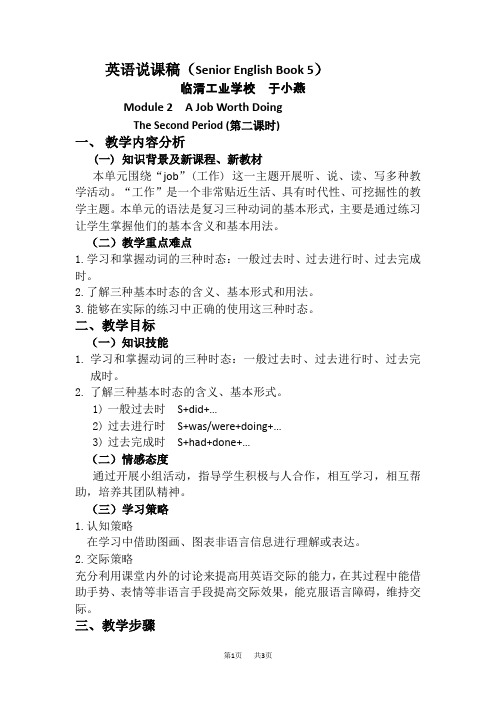
英语说课稿(Senior English Book 5)临清工业学校于小燕Module 2 A Job Worth DoingThe Second Period (第二课时)一、教学内容分析(一) 知识背景及新课程、新教材本单元围绕“job”(工作) 这一主题开展听、说、读、写多种教学活动。
“工作”是一个非常贴近生活、具有时代性、可挖掘性的教学主题。
本单元的语法是复习三种动词的基本形式,主要是通过练习让学生掌握他们的基本含义和基本用法。
(二)教学重点难点1.学习和掌握动词的三种时态:一般过去时、过去进行时、过去完成时。
2.了解三种基本时态的含义、基本形式和用法。
3.能够在实际的练习中正确的使用这三种时态。
二、教学目标(一)知识技能1.学习和掌握动词的三种时态:一般过去时、过去进行时、过去完成时。
2.了解三种基本时态的含义、基本形式。
1)一般过去时S+did+…2)过去进行时S+was/were+doing+…3)过去完成时S+had+done+…(二)情感态度通过开展小组活动,指导学生积极与人合作,相互学习,相互帮助,培养其团队精神。
(三)学习策略1.认知策略在学习中借助图画、图表非语言信息进行理解或表达。
2.交际策略充分利用课堂内外的讨论来提高用英语交际的能力,在其过程中能借助手势、表情等非语言手段提高交际效果,能克服语言障碍,维持交际。
三、教学步骤(一)Revision这部分的重点是复习上一节课学习的课文,以问答或复述的方式来进行。
活动步骤:1.师生互动:教师根据课文的内容提出问题。
1.What was his job?2. What was he doing when he came off the road one day?3. What had he done before he volunteered?4. What did he get for directing the traffic?5. What made him start this job?2.小组活动:要求学生进行小组合作,对以上的问题进行讨论后回答。
英语动词时态讲解教案(5篇范文)

英语动词时态讲解教案(5篇范文)第一篇:英语动词时态讲解教案英语动词时态讲解(共5课时)一:总述:动词的构成(5种)与时态(8种)二:分述:动词的构成 1.be 动词1)be动词的几种形式: am is arewas werebeingBeen 2)与名词、数词、形容词、介词连用 1)I am a doctor.2)He is ten.3)They are tired.4)The cat is under the table.3)There be 句型用于不可数名词和可数名词单数之前There is a pen on the desk.There is some water in the glass.用于复数名词之前 There are some sheep in the hill.用于一般将来时There is going to be a film in our school next Sunday.用于一般过去时 There was a book on the desk yesterday.注意:请根据时态和句中的名词选择适当形式。
4)Be 动词在时态中的运用在现在进行时中We are talking.在过去进行时中We were talking at this time yesterday 2.助动词1)几种形式1.do /don’t2.Does/ doesn’t3.Did/ didn’t4.will /won’t5.have haven’t /has hasn’t/had hadn’t 2)对句子进行否定和疑问1)Do you get up early every day? 2)I didn’t have lunch yesterday.3)Will you be back soon? 4)He hasn’t finished the work yet.在反意疑问句中5)He works in a school, doesn’t he? 6)She has never been there,has she? 在倒装句中7)They helped the farmers , so did we.8)I won’t visit thefamous singer,neither will he.3.情态动词共同特点: 情态动词后面跟动词原型,无论否定、疑问、倒装句、或反意疑问句都用情态动词1 只有时态变化,没有人称变化。
英语ⅱ外研版module7revision时态和语态学案
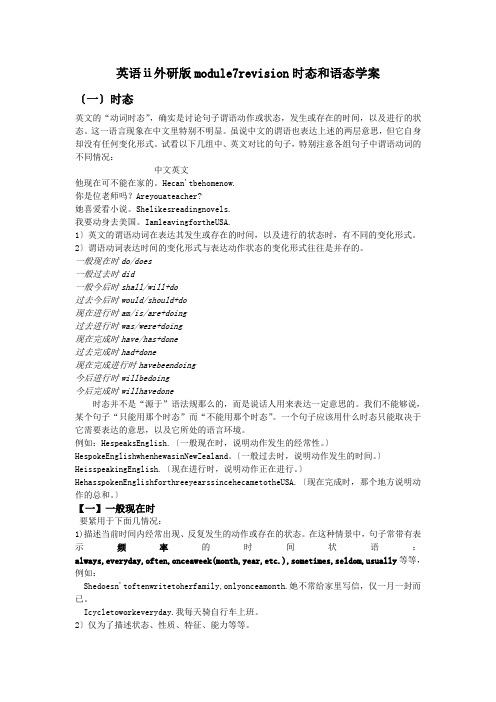
英语ⅱ外研版module7revision时态和语态学案〔一〕时态英文的“动词时态”,确实是讨论句子谓语动作或状态,发生或存在的时间,以及进行的状态。
这一语言现象在中文里特别不明显。
虽说中文的谓语也表达上述的两层意思,但它自身却没有任何变化形式。
试看以下几组中、英文对比的句子,特别注意各组句子中谓语动词的不同情况:中文英文他现在可不能在家的。
Hecan'tbehomenow.你是位老师吗?Areyouateacher?她喜爱看小说。
Shelikesreadingnovels.我要动身去美国。
IamleavingfortheUSA.1〕英文的谓语动词在表达其发生或存在的时间,以及进行的状态时,有不同的变化形式。
2〕谓语动词表达时间的变化形式与表达动作状态的变化形式往往是并存的。
一般现在时do/does一般过去时did一般今后时shall/will+do过去今后时would/should+do现在进行时am/is/are+doing过去进行时was/were+doing现在完成时have/has+done过去完成时had+done现在完成进行时havebeendoing今后进行时willbedoing今后完成时willhavedone时态并不是“源于”语法规那么的,而是说话人用来表达一定意思的。
我们不能够说,某个句子“只能用那个时态”而“不能用那个时态”。
一个句子应该用什么时态只能取决于它需要表达的意思,以及它所处的语言环境。
例如:HespeaksEnglish.〔一般现在时,说明动作发生的经常性。
〕HespokeEnglishwhenhewasinNewZealand。
〔一般过去时,说明动作发生的时间。
〕HeisspeakingEnglish.〔现在进行时,说明动作正在进行。
〕HehasspokenEnglishforthreeyearssincehecametotheUSA.〔现在完成时,那个地方说明动作的总和。
动词时态教案
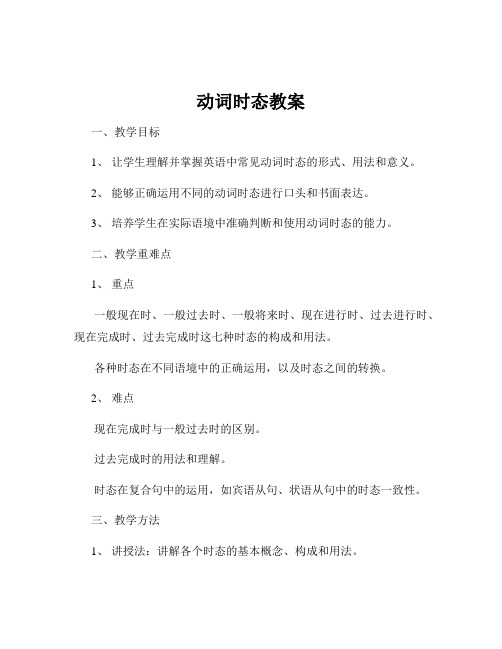
动词时态教案一、教学目标1、让学生理解并掌握英语中常见动词时态的形式、用法和意义。
2、能够正确运用不同的动词时态进行口头和书面表达。
3、培养学生在实际语境中准确判断和使用动词时态的能力。
二、教学重难点1、重点一般现在时、一般过去时、一般将来时、现在进行时、过去进行时、现在完成时、过去完成时这七种时态的构成和用法。
各种时态在不同语境中的正确运用,以及时态之间的转换。
2、难点现在完成时与一般过去时的区别。
过去完成时的用法和理解。
时态在复合句中的运用,如宾语从句、状语从句中的时态一致性。
三、教学方法1、讲授法:讲解各个时态的基本概念、构成和用法。
2、练习法:通过练习题让学生巩固所学知识,加深对时态的理解和运用。
3、情景教学法:创设各种实际情景,让学生在具体语境中感受和运用动词时态。
四、教学过程1、导入通过展示一些包含不同时态的句子,如:“I play basketball every day” “I played basketball yesterday” “I will play basketball tomorrow” 让学生观察并思考这些句子中动词形式的变化,从而引出动词时态的概念。
2、一般现在时(1)构成:主语+动词原形(当主语为第三人称单数时,动词要加“s”或“es”)(2)用法:表示经常发生的动作或存在的状态;表示客观事实或普遍真理;表示主语的性格、能力、特征等。
(3)例句:He gets up at six every morning The earth moves around the sun3、一般过去时(1)构成:主语+动词的过去式(2)用法:表示过去某个时间发生的动作或存在的状态;表示过去经常或反复发生的动作。
(3)例句:I went to Beijing last year He often played football when he was a child4、一般将来时(1)构成:“will +动词原形”或“be going to +动词原形”(2)用法:表示将来要发生的动作或存在的状态。
高中英语《动词时态与语态总结》教案
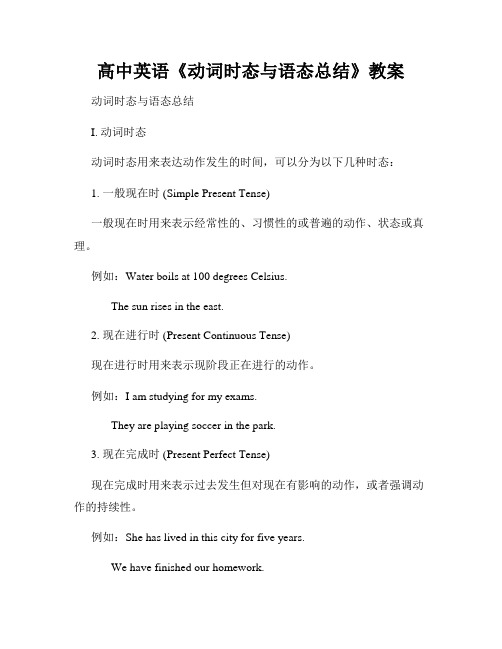
高中英语《动词时态与语态总结》教案动词时态与语态总结I. 动词时态动词时态用来表达动作发生的时间,可以分为以下几种时态:1. 一般现在时 (Simple Present Tense)一般现在时用来表示经常性的、习惯性的或普遍的动作、状态或真理。
例如:Water boils at 100 degrees Celsius.The sun rises in the east.2. 现在进行时 (Present Continuous Tense)现在进行时用来表示现阶段正在进行的动作。
例如:I am studying for my exams.They are playing soccer in the park.3. 现在完成时 (Present Perfect Tense)现在完成时用来表示过去发生但对现在有影响的动作,或者强调动作的持续性。
例如:She has lived in this city for five years.We have finished our homework.4. 一般过去时 (Simple Past Tense)一般过去时用来表示发生在过去的某个具体时间的动作或状态。
例如:I visited my grandparents last weekend.They studied together in college.5. 过去进行时 (Past Continuous Tense)过去进行时用来表示过去某个时间段内正在进行的动作。
例如:She was watching a movie when I called her.They were playing basketball yesterday.6. 过去完成时 (Past Perfect Tense)过去完成时用来表示过去某个时间点之前已经发生的动作或状态。
例如:He had already eaten dinner when I arrived.They had finished the project before the deadline.7. 将来时 (Future Tense)将来时用来表示将要发生的动作或状态。
高中英语动词时态教案5篇

高中英语动词时态教案5篇教学中,备课是一个必不可少、极其重要的环节,备课不充分或者备得不好,会严重影响课堂的气氛和学生的积极性,一堂准备充分的课,会令学生和老师都获益非浅。
因此,平时,我紧抓备、教、改、辅、查等教学中的重要环节。
以下是我带来的高中英语动词时态教案内容,感谢您的阅读,希望能援助到您!高中英语动词时态教案1一.教材解读(Material Interpretation) 通常人们忌讳“只见树木,不见森林”,然而这里我们姑且就一个单元这只林片木来想象一下那片充盈神奇的森林。
从某种意义上说,这或许正是这套教材的编写者们的用意所在。
高一英语新教材的编写依然以单元为单位,但每个单元打破了呆板的块状设计,换之于流畅的线型流程,为课堂教学的灵活组织留下了更大的空间。
整个教材体现了municative Curriculum的指导思想。
每个单元以功能为主题,话题为支撑,结构为平台,任务为载体,意义交流为目的,充分体现了语言运用的基本思路,为任务型课堂教学构建了框架,注重提高学生用英语获取信息、处理信息、分析和解决问题的能力,发展学生与人沟通和合作的能力。
本单元的主题是Technology,中心话题为Hi-tech,话题本身具有强烈的时代气息,贴近学生的实际生活,符合学生的认知水平,在学生中有较强的认同感。
这一单元的交际功能项目(Functional Item)有两个:1. Describing things2. Expressing agreement disagreement。
结构项目(Structure)为The Present Continuous Passive Voice;主要能力项目为Reading 和Writing,其中一个阅读正篇,两个Language Input, 要求学生学会阅读并在阅读中培养根据上下文或构词法理判断词义的能力,同时学会写信并在信中阐述问题的症结,发表自己的观点。
拓展项目为如何运用高科技获取更多英语信息,提升英语学习,并探究科技为人类带来便利的同时可能存在的负面影响以及消除这些影响的解决办法。
高二英语动词的时态教案
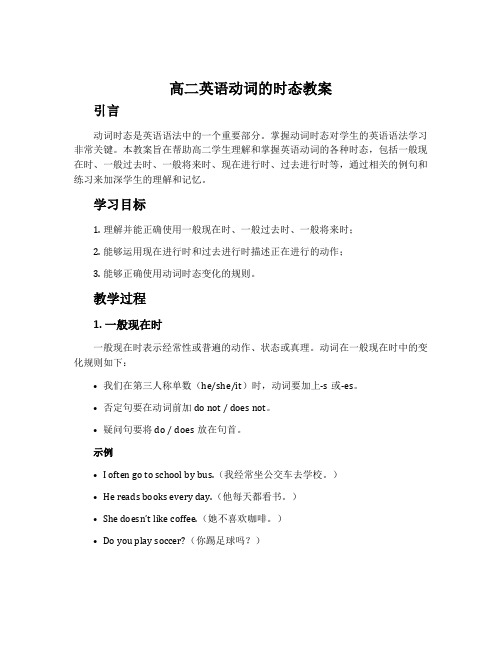
高二英语动词的时态教案引言动词时态是英语语法中的一个重要部分。
掌握动词时态对学生的英语语法学习非常关键。
本教案旨在帮助高二学生理解和掌握英语动词的各种时态,包括一般现在时、一般过去时、一般将来时、现在进行时、过去进行时等,通过相关的例句和练习来加深学生的理解和记忆。
学习目标1.理解并能正确使用一般现在时、一般过去时、一般将来时;2.能够运用现在进行时和过去进行时描述正在进行的动作;3.能够正确使用动词时态变化的规则。
教学过程1. 一般现在时一般现在时表示经常性或普遍的动作、状态或真理。
动词在一般现在时中的变化规则如下:•我们在第三人称单数(he/she/it)时,动词要加上-s或-es。
•否定句要在动词前加do not / does not。
•疑问句要将do / does放在句首。
示例•I often go to school by bus.(我经常坐公交车去学校。
)•He reads books every day.(他每天都看书。
)•She doesn’t like coffee.(她不喜欢咖啡。
)•Do you play soccer?(你踢足球吗?)2. 一般过去时一般过去时表示过去某个时间发生的动作或存在的状态。
动词在一般过去时中的变化规则如下:•动词大部分直接在词尾加-ed。
•以不发音的e结尾的动词,只加-d。
•以重读闭音节结尾的单词,双写结尾的辅音字母再加-ed。
•否定句要在动词前加did not / didn’t。
•疑问句要将did放在句首。
示例•I watched a movie yesterday.(昨天我看了一部电影。
)•They didn’t go to the party.(他们没有去派对。
)•Did she play tennis last week?(她上周打网球了吗?)3. 一般将来时一般将来时表示将来某个时间将要发生的动作或存在的状态。
动词在一般将来时中的变化规则如下:•在动词前加上will。
动词时态和语态复习教案
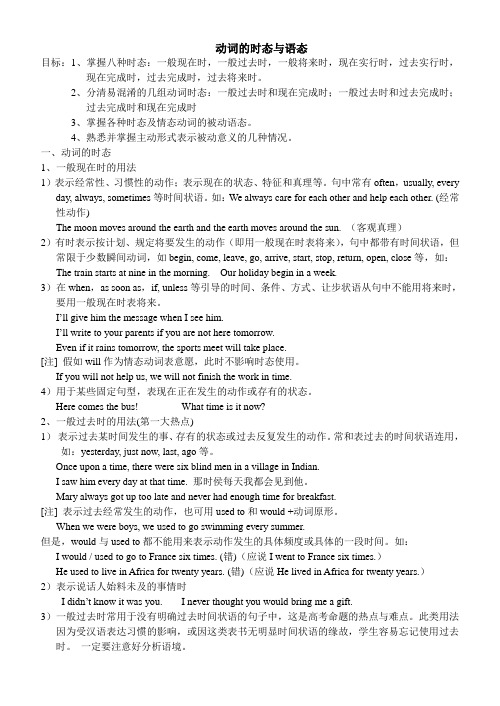
动词的时态与语态目标:1、掌握八种时态:一般现在时,一般过去时,一般将来时,现在实行时,过去实行时,现在完成时,过去完成时,过去将来时。
2、分清易混淆的几组动词时态:一般过去时和现在完成时;一般过去时和过去完成时;过去完成时和现在完成时3、掌握各种时态及情态动词的被动语态。
4、熟悉并掌握主动形式表示被动意义的几种情况。
一、动词的时态1、一般现在时的用法1)表示经常性、习惯性的动作;表示现在的状态、特征和真理等。
句中常有often,usually, every day, always, sometimes等时间状语。
如:We always care for each other and help each other. (经常性动作)The moon moves around the earth and the earth moves around the sun. (客观真理)2)有时表示按计划、规定将要发生的动作(即用一般现在时表将来),句中都带有时间状语,但常限于少数瞬间动词,如begin, come, leave, go, arrive, start, stop, return, open, close等,如:The train starts at nine in the morning. Our holiday begin in a week.3)在when,as soon as,if, unless等引导的时间、条件、方式、让步状语从句中不能用将来时,要用一般现在时表将来。
I’ll give him the message when I see him.I’ll write to your parents if you are not here tomorrow.Even if it rains tomorrow, the sports meet will take place.[注] 假如will作为情态动词表意愿,此时不影响时态使用。
高二英语期末复习 动词的时态和语态 知识精讲 外研社
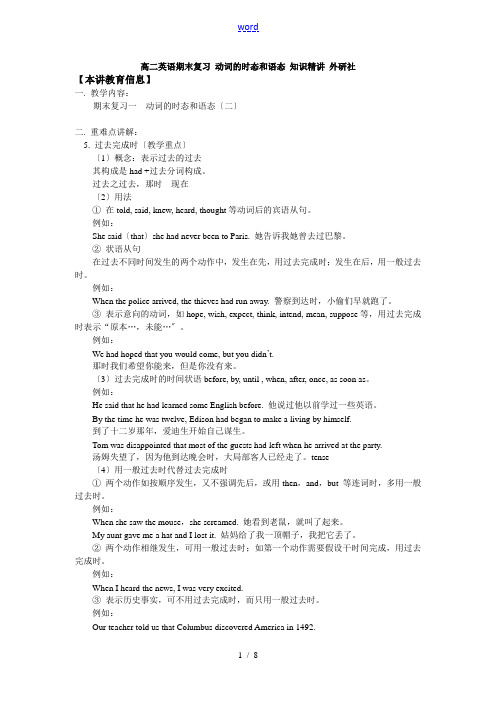
高二英语期末复习动词的时态和语态知识精讲外研社【本讲教育信息】一. 教学内容:期末复习一动词的时态和语态〔二〕二. 重难点讲解:5. 过去完成时〔教学重点〕〔1〕概念:表示过去的过去其构成是had +过去分词构成。
过去之过去,那时现在〔2〕用法①在told, said, knew, heard, thought等动词后的宾语从句。
例如:She said〔that〕she had never been to Paris. 她告诉我她曾去过巴黎。
②状语从句在过去不同时间发生的两个动作中,发生在先,用过去完成时;发生在后,用一般过去时。
例如:When the police arrived, the thieves had run away. 警察到达时,小偷们早就跑了。
③表示意向的动词,如hope, wish, expect, think, intend, mean, suppose等,用过去完成时表示“原本…,未能…〞。
例如:We had hoped that you would come, but you didn’t.那时我们希望你能来,但是你没有来。
〔3〕过去完成时的时间状语before, by, until , when, after, once, as soon as。
例如:He said that he had learned some English before. 他说过他以前学过一些英语。
By the time he was twelve, Edison had began to make a living by himself.到了十二岁那年,爱迪生开始自己谋生。
Tom was disappointed that most of the guests had left when he arrived at the party.汤姆失望了,因为他到达晚会时,大局部客人已经走了。
tense〔4〕用一般过去时代替过去完成时①两个动作如按顺序发生,又不强调先后,或用then,and,but 等连词时,多用一般过去时。
高二英语期末复习:动词的时态和语态(三)外研社

高二英语期末复习:动词的时态和语态〔三〕外研社【本讲教育信息】一. 教学内容:期末复习:动词的时态和语态〔三〕二. 重难点讲解:2. 被动语态考查要点简述被动语态的构成方式:be + 过去分词,口语中也有用get / become + 过去分词表示。
被动语态的根本用法:不知道或没必要提到动作的执行者是谁时用被动语态。
强调或突出动作的承受者常用被动语态〔by短语有时可以省略〕。
〔1〕使用被动语态时应注意的几个问题。
①主动变化被动时双宾语的变化。
看如下例句。
My friend gave me an interesting book on my birthday.An interesting book was given to me〔by my friend〕on my birthday.I was given an interesting book 〔by my friend〕on my birthday.②主动变被动时,宾补成主补〔位置不变〕;〔作补语的〕不定式前需加to。
The boss made him work all day long.He was made to work all day long〔by the boss〕③短语动词变被动语态时,勿要掉“尾巴〞。
The children were taken good care of 〔by her〕.Your pronunciation and spelling should be paid attention to.④情态动词和be going to、be to、be sure to、used to、have to、had better等结构变被动语态,只需将它们后面的动词原形变为be +过去分词。
⑤当句子的谓语为say、believe、expect、think、know、write、consider、report等时,被动语态有两种形式:〔A〕谓语动词用被动语态,动词不定式作主补。
- 1、下载文档前请自行甄别文档内容的完整性,平台不提供额外的编辑、内容补充、找答案等附加服务。
- 2、"仅部分预览"的文档,不可在线预览部分如存在完整性等问题,可反馈申请退款(可完整预览的文档不适用该条件!)。
- 3、如文档侵犯您的权益,请联系客服反馈,我们会尽快为您处理(人工客服工作时间:9:00-18:30)。
高二英语动词的时态语态专项练习外研社【本讲教育信息】一. 教学内容:动词的时态语态专项练习二. 重难点讲解:动词的时态和语态在接下来的时间里将给大家介绍一下动词的时态和语态。
到目前为止大家应该知道,动词共有16种时态和两种语态。
在时态方面,考题中主要涉及到其中的10种:一般现在时、一般过去时、一般将来时、现在进行时、现在完成时、过去将来时、过去进行时、过去完成时、将来进行时、将来完成时、现在完成进行时。
1. 一般现在时:通常有六种用法,其中最重要的考点是:在时间或条件状语从句中表示将来的动作;安排或计划好的将来发生的动作。
如:1>. The train for Shanghai leaves at 11a.m and arrives at 11p.m.2>. As soon as the manager comes back, I will tell him about it.2. 一般过去时:关于该时态最主要请大家掌握它的概念:一个开始于过去结束于过去的动作,或存在的状态。
记住这一点很重要,需要与现在完成时区分。
如:The other day she ran across an old friend in the street.3. 一般将来时:除了用will + 动词原形表示该时态外,还有:1> Be going to do sth:She is going to go abroad next year.2> Be about to do sth:Please fasten your safety belt, for the plane is about to take off.3> Be to do sth:There is to be a class meeting this afternoon.4. 现在进行时:除了众所周知的表正在进行动作外,还有如下特殊用法:预计一个将要发生的动作;常与某些副词连用,表示某种感情色彩,如赞叹、惊讶或不满。
如:1> How many of you are going to the party tonight.2> The teacher is always criticizing us.5. 现在完成时:这应该是五个基本时态中最令大家迷惑的一个。
该时态分为已完成和未完成两种。
常见的标志性的词有:since, for, already, so far, up to now, in the last few years, in the past three months etc.如:1> He has lived here since he got married.2> In the past two decades, research has expanded our knowledge about sleep and dreams.3> In the last ten years great changes have taken place in China.6. 过去将来时:只有一个考点:用于主句的谓语动词是过去时态的间接引语中,遵循时态呼应原则。
如:she said she would pay us a visit when she had enough time.7. 过去进行时:表示在过去的某个时刻发生的动作或某段时间内一直进行的动作。
如:1> At nine o’clock last night, I was counting the stars in the sky.2> When the girl came in, the two dogs were fighting for a bone.3> While I was preparing for the exam, the power was cut off.8. 过去完成时:别名“过去的过去。
”考题中对该时态的使用有要求,只有当句中有一个动作是过去时,才有可能用过去完成。
如:1> The film had almost finished when I got to the cinema.2> By the time he was ten, he had built himself a chemistry lab.9. 将来完成时:该时态只有一个考点,请大家注意与过去完成的区别:如:By the time he is ten, he will have built himself a chemistry lab.10. 现在完成进行时:表示现在以前一直发生的动作,强调动作在进行过程中的不间断,常有背景句作为铺垫。
如:—Y ou are all wet!—Y es, I have been playing basketball all the morning.语态:主要考察被动语态的用法。
基本公式:主语+ be + 动词的过去分词。
还有一个要点大家需记住:只有及物动词才有被动语态。
除了大家熟悉的基本用法外,被动语态还有一些特殊用法,比如用主动的形式表达被动的概念,顾名思义,看起来是主动,实则为被动。
下面,我们将英文中常见的主动形式表被动含义的情况总结一下:1> 动词read, sell, last, wash, write, lock等带状语,如well, easily时.e.g.①This kind of cloth washes easily.(这种布好洗)②The meeting lasted three hours.(会议持续了三个小时)③My new pen writes well. (我的新钢笔好写)2> 感官动词feel, look, smell, sound, taste, prove等与形容词连用时.e.g. ①Y ou look very well today.②Y our bedroom smelt so terrible.③My words proved right.3> begin, end, stop, open, close等表示开,关,结束的含义时,及break out, take place, happen等动词表示爆发,发生概念时。
e.g. ①The library opens at ten.②Class begins at half past eight.③An earthquake took place in Tang Shan in 1976.4> 某些做表语的形容词后,用不定式的主动形式。
e.g. ①The question is easy to answer.②His clothes are hard to wash.③The fish is not fit to eat.④He has an important meeting to attend.【典型例题】1. I can guess you were in a hurry. Y ou your sweater inside out.A. had wornB. woreC. were wearingD. are wearing2. —We that you would fix the TV set this week.—I’m sorry. I to, but I’ve been too busy.A. had expected;had intendedB. are expecting;had intendedC. expect;intendD. expected;intend3. He will stop showing off, if no notice of him.A. is takenB. will be takenC. takesD. has taken4. —It is said that another new car factory now.—Y eah. It one and a half years.A. is building;takesB. is being built;will takeC. is built;will takeD. is being built;takes5. —I’m sorry, but I shouldn’t have been so rude to you.—Y ou your temper but that’s OK.A. have lostB. had lostC. did loseD. were losing6. — Why? Tom, your shirt is so dirty!—Mum, I my storeroom downstairs。
A. cleanedB. have workedC. was cleaningD. have been cleaning7. They won’t buy new clothes because they money to buy a color TV set.A. saveB. are savingC. has savedD. were saving8. Good heavens! There you are! We anxious about you, and we you back throughout the night.A. are;expectB. were;had expectedC. have been;were expectingD. are;were expecting9. I’ve finally finished my paper and it me an entire month.A. takesB. tookC. was takenD. had taken10. The traffic in our city is already good and it even better.A. getsB. gotC. has gotD. is getting11. — Has Jack finished his homework yet?—I have no idea;he it this morning.A. was doingB. had been doingC. has doneD. did12. — I will come to attend your lecture at 10:00 tomorrow.—I’m sorry, by then my lecture will have ended and I my guests in my office.A. is being metB. will meetC. will be meetingD. will have met13. — Alice came back home the day before yesterday.—Really ? Where ?A. has she beenB. had she beenC. has she goneD. had she gone14. John and I friends for eight years. We first got to know each other at a Christmas party. But we each other a couple of times before that.A. had been;have metB. have been;have metC. had been;had metD. have been;had met15. I ping-pong quite well, but I haven’t had time to play since the new year.A. will playB. have playedC. playedD. play16. I’ve won a holiday for two to Florida. I my mum.A. takeB. am takingC. have takenD. will have taken17. —Y ou haven’t said a word about my new coat, Brenda. Do you like it?—I’ m sorry I anything about it sooner. I certainly think it’s pretty on you.A. wasn’t sayingB. don’t sayC. won’t sayD. didn’t say18. —Where ?—I got stuck in the heavy traffic. I here earlier.A. did you go;had arrivedB. have you been;would have beenC. were you;would comeD. are you;was19. I know Mr. Brown;we to each other at an international conference.A. are introducedB. have been introducedC. were introducedD. had been introduced20. —Where do you think he the computer?— Sorry. I have no idea.A. has ;boughtB./;boughtC. did ;buyD. had ;bought21. —I to a party, but I’ve got nothing to wear.— Why don’t you have a dress made for the party?A. was askedB. will askC. have askedD. have been asked22. I didn’t like Aunt Lucy, who without warning and bringing us presents.A. always turned upB. has always turned upC. was always turning upD. was always turned up23. —What do you think of this kind of TV set, which in Shanghai?—Well, I don’t care such things.A. was madeB. is madeC. has been madeD. had been made24. — Tom, did Mr. Li join you in your discussion?—No, he , but he happened to have fallen ill.A. would like toB. willC. was to haveD. was going to join25. — Did he notice you enter the room?—I don’t think so. He__to the radio with his eyes shut.A. listenedB. was listeningC. has listenedD. had listened26. The plane at 7:00 p.m., so I have to be at the airport by 6:40 at the latest.A. has leftB. is to leaveC. will have leftD. leaves27. The train at the present speed until it reaches the foot of the mountain at about nine o’clock tonight.A. wentB. is goingC. goesD. will be going28. Look at this! I some magazines and this letter.A. was looking through;foundB. am looking through;findC. looked through;had foundD. had looked through;finding29. —you the editor at the airport?—No, he away before my arrival.A. Have...met;has drivenB. Had...met;was drivenC. Did...meet;had been drivenD. Have...met;had driven30. — Can you give me the right answer?—Sorry, I .Would you repeat that question?A. hadn’t listenedB. haven’t listenedC. don’t listenD. wasn’t listening答案:1. D。
